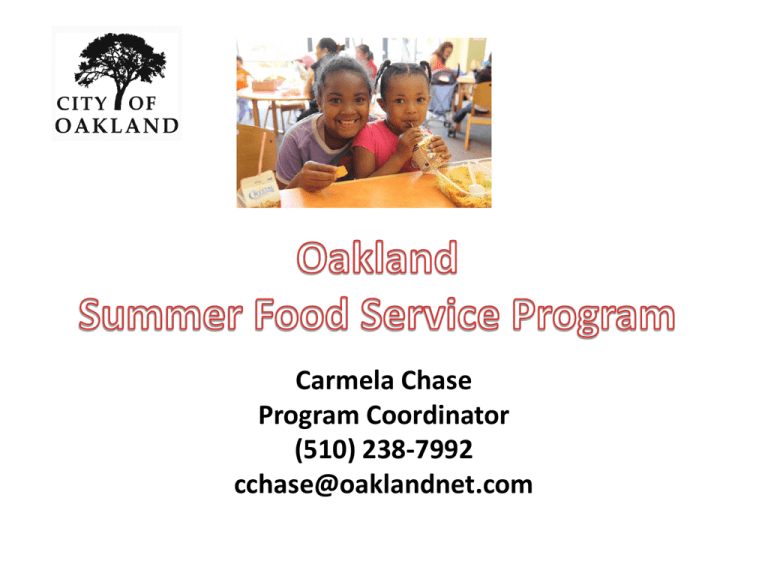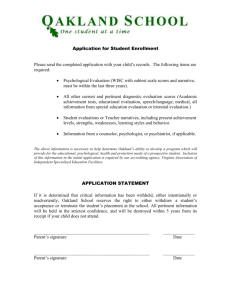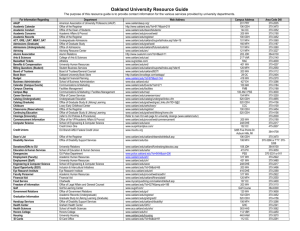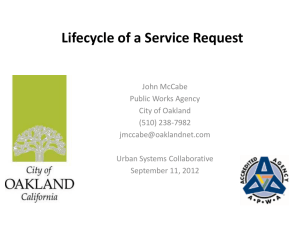City of Oakland Summer Food Service Program
advertisement

Carmela Chase Program Coordinator (510) 238-7992 cchase@oaklandnet.com Our Mission • The Summer Lunch Program strives to help children in Oakland get the nutrition they need to learn, play, and grow throughout the summer—making them better prepared to start another school year. The Summer Lunch Program encourages healthy eating habits leading to normal weight ranges and a positive self-image. Our success! • The City of Oakland has been a sponsor of the Summer Food Service Program for the past 28 years • Summer food sites increased from 60 locations in 2010 to 96 in 2012. • The number of meals served has nearly doubled since the early 2000’s, from 45,000 lunches to 91,000 lunches and 82,000 afternoon snacks served, as Oakland families experience high rates of unemployment and poverty. Two Oakland Summer Food Sponsors Oakland Unified School District (OUSD) serves breakfast and lunch to summer schools and community programs held on OUSD property. The City of Oakland’s Summer Food Service Program fills in the gaps by partnering with local organizations. Some of the City’s many partners for the Oakland Summer Lunch Program include: • • • • • City of Oakland Recreation Centers Many non-profit organizations serving children Faith based organizations New! City of Oakland Libraries All summer food sites such as recreation centers, community based and faith based organizations experienced an increase of meals served during the last summer session. New partnerships with the libraries and cross promotion of literacy programs accompanied by free meals increased community attendance. Alameda Community Food Bank Awesome Volunteers!!!! • For several years, the Alameda County Community Food Bank has assisted the City of Oakland’s Summer Food Service Program with outreach and promotion through their Emergency Helpline. 800-870-FOOD In 2011, the Food Bank embarked on a unique pilot project with the City of Oakland to provide summer lunch in an entirely new place: the Oakland Public Libraries. What began as a two week trial at 3 libraries, blossomed into a summerlong effort at 10 different library branches. While the libraries could provide the space and storage, they did not have the staffing to distribute and monitor the lunches. The Food Bank agreed to dip into their extensive pool of volunteers and take on the role of recruiting and training the volunteers needed to run these sites. In 2012, the Food Bank provided 99 volunteers to serve and monitor the lunches at the different locations. By the end of the summer, nearly 7,400 meals were served through the collaboration. How it works To participate as a site, all organization must: • Provide an area where lunches can be served to children • All site staff must attend training • Have the ability to store and refrigerate lunches • Trainings are provided from late May through the end of July • A site coordinator(s) to serve and count lunches during the designated meal time Best Practices with Libraries • Two volunteers for every 20-30 children: The site with 70 children daily needed just three to four volunteers daily as the parents who accompanied their children helped with cleaning. • Boxed lunches make for easy storage and clean-up. • Dedicate one person to the schedule and coordination of volunteers: Having an intern act as volunteer coordinator saves staff valuable time. • Train volunteers prior to their shift start: Volunteers arrived 30 minutes prior to their first shift to receive training. Explaining the rules and regulations took up the bulk of training. • Screen and select volunteers willing to do multiple shifts: Most volunteers did 3 or more shifts, either doing several days in a row or the same day for multiple weeks. • Utilize staff refrigerators: For most of the libraries, their staff refrigerators had adequate storage space. It was only the high volume library that required an additional mini-fridge. • Library staff accept and store the food when delivered: This was the one piece of work that the libraries agreed to do because the food usually arrived 2-3 hours before lunch was served. They agreed to accept the food, store it and record its temperature. Get the word out! Food Banks, Flyers at local School, Fun Kick off event, 211, Twitter, Facebook, Door hangers, Local news stations!












